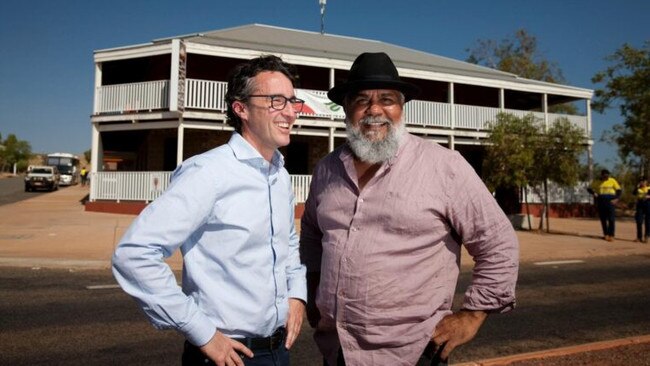Emission Control: Traditional owners plan to become major players in renewables
The traditional owners of lands that host some of the world’s largest iron ore mines are set to play a major role in a huge renewable energy expansion.

Stockhead
Don't miss out on the headlines from Stockhead. Followed categories will be added to My News.
Having fought for decades to have their right to benefit from the wealth of mining projects across their cultural lands, traditional owners linked to some of Australia’s largest miners are looking to play a major role in the development of a massive expansion of renewable power in their backyard.
The Yindjibarndi people, the traditional custodians of land incorporating some of Australia and the world’s largest iron ore mines and the famous Pilbara town of Roebourne, say Rio Tinto (ASX:RIO) is poised to become the first customer of a solar and wind network on their land that could run to 3GW of renewable installations.
For the latest mining news, sign up here for free Stockhead daily newsletters
Early works – including a flora and fauna survey on land around 50km from Karratha as the crow flies – have already begun on an initial installation that could deliver 75-150MW of solar energy for use by Rio.
The company which operates a massive mine, port and rail iron ore network across the Pilbara that counts as the world’s largest iron ore export business.
It predicts it will need 600-700MW of renewable generation to displace most of the gas used at its operations, as it tackles a 3.3Mt a year CO2 millstone (which it wants to cut in half by 2030) at its Pilbara mines.
It is making a $US3 billion investment to begin the decarbonisation process at its operations.
Rio has already built a 34MW solar farm consisting of 81,000 odd panels across eight Optus Stadiums at its Gudai-Darri mine, with plans to assess another 300MW.
On top of its own projects, Rio has signed a memorandum of understanding with Yindjibarndi Energy.
This is a planned JV between the Yindjibarndi People and Philippines-based ACEN Corporation, under which would the traditional owners will have between 25 per cent and 50 per cent ownership in any renewable project developed.
Yindjibarndi Energy CEO Craig Ricato said the company was hopeful of hitting FID (a final investment decision) by the end of next year and making commercial arrangements in 2025 ahead of a 12-18 month build.
MORE FROM STOCKHEAD: Giants eye Azure | On the Canadian uranium train | Lithium M&A scene still hot
Yindjibarndi Aboriginal Corporation CEO Michael Woodley said at an announcement in Roebourne last Friday that the group was eager to take a lead role in rollout of renewables in the Pilbara.
“We obviously have our views in terms of mining, but we think entering into this space is not only good for Yindjibarndi, it’s good for our community, it’s good for our country, and it’s good for the world,” he said.
“It’s gonna be part of something that is going to contribute to the world economy, but in a different shift.”
Rio talks opportunities and challenges
Rio Tinto, as well as its competitors Fortescue (ASX:FMG) and BHP (ASX:BHP), face an uphill task to rein in their emissions.
They count as some of Australia’s biggest industrial polluters, though their biggest impact is in scope 3 emissions, which dwarf scope 1 and 2 emissions generated at the mine.
As a guide:
- Scope 1 emissions are those owned or controlled by a company.
- Scope 2 emissions are indirect emissions from the generation of energy an operation has purchased.
- Scope 3 emissions are all other indirect emissions from an organisation’s value chain. That is, those it does not own or control.
Solutions to curb those will rely on technology to make the global steel industry green – still likely wedded happily or otherwise to coal for years, if not decades, to come.
But efforts and capital are being concentrated on opportunities to take emissions out of the mines, port and rail networks.
Green hydrogen peddling Fortescue has boldly claimed it will hit “real zero” at a cost of $US6.2 billion by 2030. Rio and BHP are more moderate, but are also investing billions.
Approval times for mines have doubled in the past 20 years and there are concerns the renewable rollout will also be impacted by the increasing rigidity of environmental approvals and strain placed on under-resourced government agencies.
Visit Stockhead, where ASX small caps are big deals
Having the traditional owner group with its in-house knowledge of cultural sites could provide an advantage and a template when it comes to getting green energy projects off the ground.
“One of the good things about this type of project you can go about selecting, where would be an appropriate place that doesn’t interfere or impact with significant cultural areas on sites, river systems, waterways and important places, for the Yindjibarndi People,” Woodley said.
“We work closely with our elders and then we obviously land on a site that is obviously going to be best for the Yindjibarndi people when we’re considering those things.”

Wrinkles in time
Rio has its own invidious recent history when it comes to Indigenous relations.
Notably, shareholders forced a clear out of senior leadership after the destruction of WA’s Juukan Gorge rock shelter in a 2020 blast.
It has recently been under the microscope, though is not talking further at the moment, after a blast at the Nammuldi mine disturbed a rock shelter and known cultural site 150m away on August 6.
The Yindjibarndi continue to pursue a pitched fight with Fortescue for compensation for the Solomon mining hub, which they say was established and mined on their land without their approval.
Woodley declined to talk about the court case or hopes of ending the dispute with a settlement.
Rio Tinto’s iron ore chief Simon Trott said Rio continued to be open to look at opportunities to partner with traditional owners in the renewable energy space.
“We continue to be open to discussions with Yindjibarndi on this arrangement and on future arrangements, as we are with other parties within the Pilbara that are looking to progress renewables,” Trott said.
“We’ve obviously got fairly ambitious targets for our own business.
“We’ve talked previously about committing $3 billion to decarbonisation of our business here in the Pilbara. And this is a step towards that.”
Ricato said Yindjibarndi Energy was, in parallel, assessing the potential to develop a 300MW wind farm, saying around 900MW of potential wind resource has been identified on Yindjibarndi country.
While Rio would be the JV’s foundational customer, he said the business was open to supplying to other customers in the Pilbara and the state government’s North West Interconnected System.
This content first appeared on stockhead.com.au
SUBSCRIBE
Get the latest Stockhead news delivered free to your inbox.Click here
Originally published as Emission Control: Traditional owners plan to become major players in renewables


